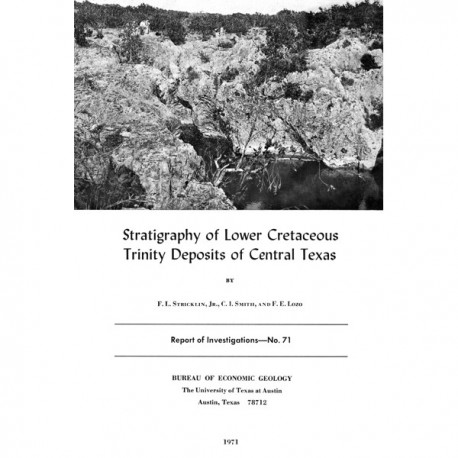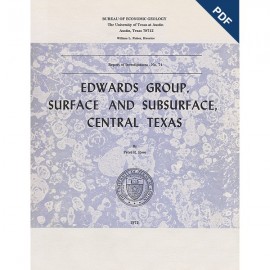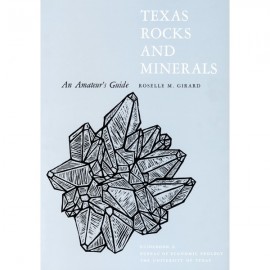Reports of Investigations
-
Books & Reports
- Reports of Investigations
- Guidebooks
- Udden Series
- Geological Circulars
- Down To Earth
- Atlases of Major Oil and Gas Reservoirs
- Texas Memorial Museum Publications
- Environmental Geologic Atlas of the Texas Coastal Zone
- Mineral Resource Circulars
- Other Reports
- Seminars and Workshops
- Handbooks
- Submerged Lands of Texas
- Symposia
- Annual Reports
- Open File Reports
-
Maps & Cross Sections
- Thematic Maps
- Miscellaneous Maps, Charts & Sections
- Geologic Atlas of Texas
- STATEMAP Project Maps
- Geologic Quadrangle Maps
- Cross Sections
- Highway Geology Map
- Energy and Mineral Resource Maps
- Shoreline Change and Other Posters
- Wilcox Group, East Texas, Geological / Hydrological Folios
- Bouguer Gravity Atlas of Texas
- River Basin Regional Studies
- Featured Maps
- Posters
- Teachers & the Public
-
Geological Society Publications
- Gulf Coast Association of Geological Societies
- Alabama Geological Society
- Austin Geological Society
- Corpus Christi Geological Society
- Houston Geological Society
- Lafayette Geological Society
- Mississippi Geological Society
- New Orleans Geological Society
- South Texas Geological Society
- GCS SEPM Publications
- Historic BEG & UT Series
Stratigraphy of Lower Cretaceous Trinity Deposits of Central Texas
RI0071
Stratigraphy of Lower Cretaceous Trinity Deposits of Central Texas, by F. L. Strickin Jr., C. I. Smith, and F. E. Lozo. 63 p., color frontispiece, 14 figs. (3 in back pocket), 15 photos, 1 appendix, 1971. ISSN: 0082335X:Print. Print Version.
A free, digital version of this publication can be found on: Texas ScholarWorks
This product is no longer in stock
RI0071. Stratigraphy of Lower Cretaceous Trinity Deposits of Central Texas, by F. L. Strickin Jr., C. I. Smith, and F. E. Lozo. 63 p., color frontispiece, 14 figs. (3 in back pocket), 15 photos, 1 appendix, 1971. ISSN: 0082335X:Print.
To purchase this publication as downloadable PDF, please order RI0071D.
ABSTRACT
Sediments of the Fredericksburg Division in south-central Texas were deposited on the slowly subsiding west flank of the Tyler basin. In this region there are three stratigraphically distinct areas. The southern area has a thick Edwards Limestone unit overlying a thin Walnut Formation. The intermediate area has a thinner Edwards sequence and Comanche Peak Limestone intervening between the Edwards and an expanded Walnut Formation. The Paluxy Sandstone occurs at the base of the Fredericksburg in the northern area, and there is further expansion of the Walnut Formation accompanied by an attenuated Edwards biohermal limestone characteristic of this formation in north-central Texas.
The Walnut Formation has six members, from bottom to top, the Bull Creek, Bee Cave, Cedar Park, Whitestone, Keys Valley, and an unnamed upper marl. The Cedar Park Limestone Member is emended to include only the nodular fossiliferous micrite below the oosparite and pelsparite occurring at the Cedar Park quarries in Williamson County. The oosparite and pelsparite are termed the Whitestone Limestone Member. A similar development in the vicinity of Moffat, Bell County, is referred to as the Moffat mound of the Edwards Formation.
The Edwards, Comanche Peak, and Walnut are gradational. The Walnut-Paluxy contact in southern Coryell County is unconformable, but regionally the two units are probably time equivalents. The Fredericksburg-Trinity and Fredericksburg- Washita contacts are interpreted to be unconformities.
The Fredericksburg Division contains 12 basic facies. The horizon[t]al and vertical distribution of these facies is shown by a series of lithotope maps, and the Fredericksburg is interpreted as a cyclic unit with a series of land-derived quartzose or argillaceous units thickening from north to south, blanketed by deeper water lime muds. The Edwards rudistid facies progressed from south to north.
Keywords: Fredericksburg Division, Edwards Plateau, Central Texas, south-central Texas
Citation
Stricklin, F. L., Smith, C. I., and Lozo, F. E., 1971, Stratigraphy of Lower Cretaceous Trinity Deposits of Central Texas: The University of Texas at Austin, Bureau of Economic Geology, Report of Investigations No. 71, 63 p.






